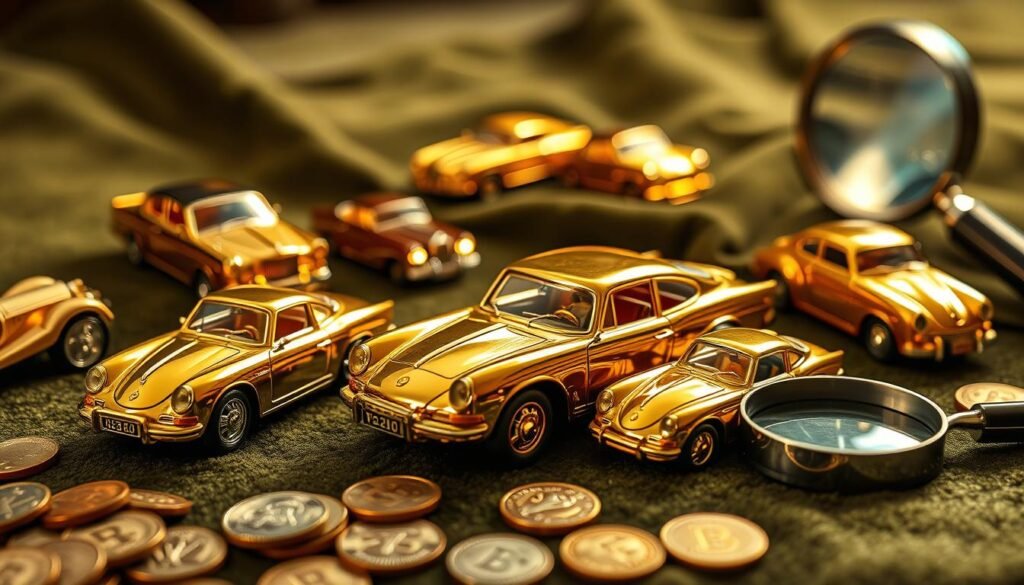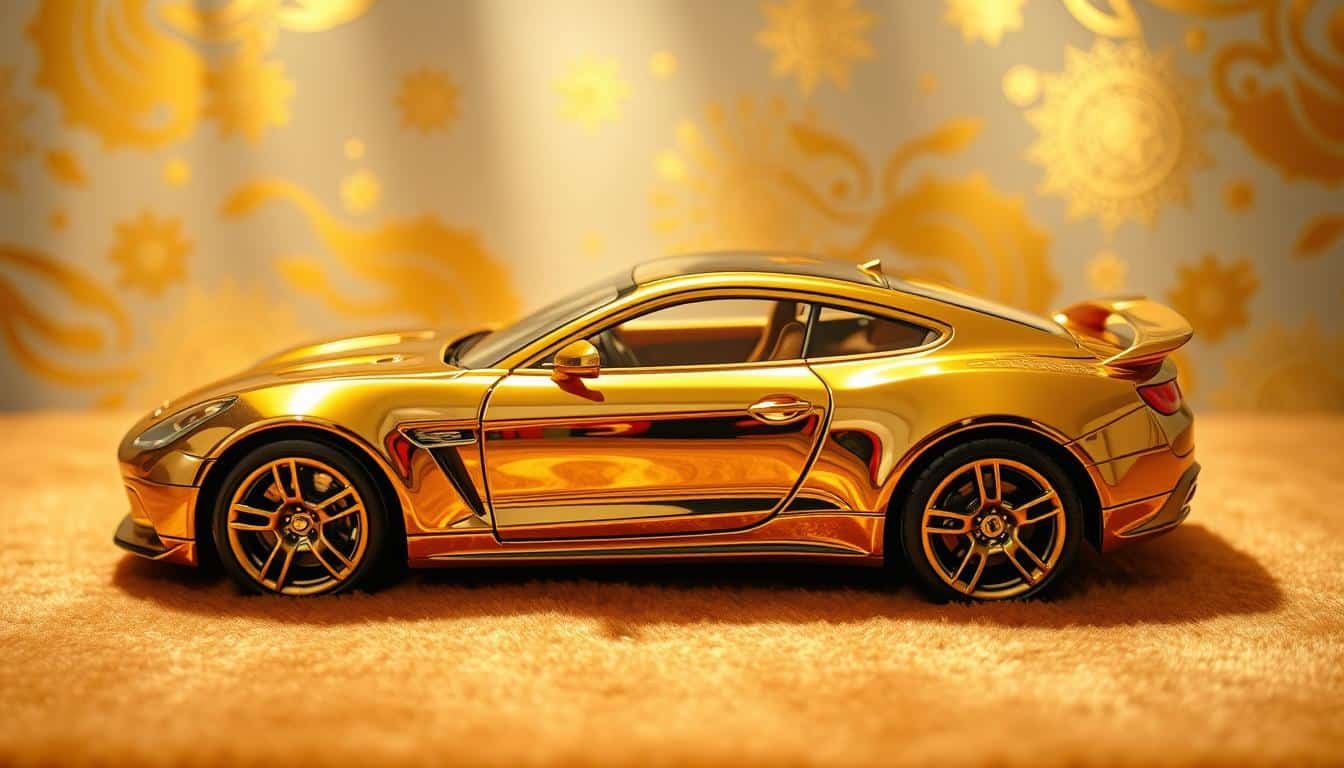Gold’s incredible malleability allows one gram to cover a square meter. This makes it perfect for plating objects like diecast cars. But are 24k gold-labeled diecast cars truly made of pure gold?
Gold-plated diecast cars fascinate collectors and enthusiasts. The idea of owning a miniature vehicle adorned with precious metal is captivating. But do these cars really contain gold?
To answer this, we must explore gold purity and plating techniques. We’ll also delve into collectible manufacturing intricacies. This knowledge helps distinguish authentic gold-plated items from imitations.
Key Takeaways
- 24k gold is 100% pure gold, but diecast cars may only be gold-plated
- Gold plating thickness varies, affecting durability and value
- Authentic gold-plated diecasts contain a thin layer of real gold
- Verification methods exist to determine gold content in collectibles
- The value of gold-plated diecast cars depends on various factors
Understanding Gold Purity and Authenticity Standards
Gold purity greatly impacts diecast car gold content value. Knowing these standards is key for gold electroplating diecasts. Let’s explore gold purity and its role in pure gold diecast cars.
What 24K Gold Really Means
24K gold is 100% pure, without any mixed metals. It has a bright yellow color and soft, pliable nature. 22K gold is 91.67% pure, while 18K gold is 75% pure.
Different Types of Gold Finishes
Diecast cars use various gold finishes. Gold plating adds a thin gold layer over another metal. The layer’s thickness affects durability and value.
Some diecast cars use gold-colored finishes. These mimic real gold’s look without containing precious metal.
Gold Content Verification Methods
Verifying gold content in diecast cars is crucial. Several methods exist:
- Hallmarking: Official stamps indicating gold purity
- Weight comparison: Pure gold has a specific density of 19.3 g/mL
- Professional testing: Using specialized equipment for accurate results
Gold-plated items often have markings showing micron thickness. For example, ’20’ might mean 20-micron gold plating. These markings help assess gold-plated diecast cars’ true value.
| Gold Purity | Karat | Percentage |
|---|---|---|
| Pure Gold | 24K | 100% |
| High Purity | 22K | 91.67% |
| Common Jewelry | 18K | 75% |
| Budget Friendly | 14K | 58.3% |
Do Diecast Cars Labeled 24k Gold Really Contain Gold
Gold-finished diecast models often spark curiosity about their true gold content. These collectibles may bear labels suggesting genuine gold. Let’s explore the gold plating process and ways to spot real gold in diecast models.
Gold Plating Process for Diecast Models
Diecast car gold plating involves applying a thin gold layer over base metal. The process uses a solution with about 1g of gold per pint. This amount can plate thousands of pieces.
Micron Thickness in Gold-Plated Collectibles
Gold plating thickness on collectibles varies widely. Some models have a layer as thin as a few microns. Others boast up to 20 microns or more.
Thicker plating enhances durability but increases production costs. Gold-filled jewelry often displays marks like “1/20 14k,” indicating gold content.
Distinguishing Between Real Gold and Gold-Colored Finishes
Spotting genuine gold diecast labeling requires keen observation. Look for specific markings, like a ’20’ in a triangle with the manufacturer’s logo. This might indicate 20-micron plating.
Weight can be another clue – gold is much heavier than common base metals. Professional testing methods exist but aren’t recommended for collectibles.
Most gold-finished diecast models contain only a small amount of real gold. Their value lies more in their collectible status. Consider factors beyond the gold label when investing in these items.
Value and Investment Considerations of Gold-Plated Diecasts

Gold-plated diecast cars captivate collectors, but their value isn’t like solid gold items. The true worth of these miniatures extends beyond their gold content. Their value depends on various factors, not just precious metal claims.
The gold-plated collectibles value depends on several factors:
- Plating thickness
- Rarity of the model
- Overall condition
- Brand reputation
Gold-plated diecasts are prized more for their collectible status than their gold content. The thin gold layer can wear off over time. This affects their long-term value, making them less of a gold investment.
These items are passion projects rather than financial investments. Their value changes based on collector demand, not gold prices. For gold investments, consider options like bullion or ETFs instead.
“Gold-plated diecasts are treasures of nostalgia, not gold reserves.”
The joy of owning these miniature marvels often surpasses their monetary worth. Cherish your collection for its beauty and rarity. Remember, it’s not meant to be a golden nest egg.
Conclusion
Diecast cars labeled “24k gold” usually have a thin gold plating, not solid gold. This detail is important for collectors to understand. Gold purity and plating processes are key aspects to consider.
These miniatures are valuable as collectibles, not for their gold content. Their worth comes from rarity, condition, and collector demand. Appreciate these items for their looks and collectible status.
Professionals use the touchstone test to check gold purity in items like diecast cars. Proper care keeps these delicate collectibles valuable and looking good.
Gold-plated diecast cars are more than just investments. They bring joy to collectors and tell unique stories. These tiny treasures offer a golden glimpse into automotive history.
FAQ
Do diecast cars labeled 24k gold really contain gold?
What does 24k gold mean in terms of purity?
How can I verify the gold content in a diecast car?
What is the difference between gold plating and solid gold in diecast cars?
How thick is the gold plating on diecast cars?
Are gold-plated diecast cars a good investment?
How can I distinguish between real gold plating and gold-colored finishes on diecast cars?
Does gold plating on diecast cars wear off over time?
Source Links
- How can you distinguish Gold Plate vs. Gold Cap and how… – https://www.watchuseek.com/threads/how-can-you-distinguish-gold-plate-vs-gold-cap-and-how-theyre-marked.486916/
- Gold – https://en.wikipedia.org/wiki/Gold
- Three signs to check for purity of gold of BIS hallmarked jewellery – https://m.economictimes.com/wealth/spend/three-signs-to-check-for-purity-of-gold-of-bis-hallmarked-jewellery/articleshow/91172525.cms
- 4 Ways to Tell if Gold Is Real – wikiHow – https://www.wikihow.com/Tell-if-Gold-Is-Real
- PDF – http://www.responsiblemines.org/images/sampledata/EstandarFairmined/Fairmined Stnd 2 0_2014_.pdf
- Gold-Plated vs Gold-Filled, Hollow vs Solid Gold Difference – https://www.automicgold.com/blogs/automic-blog/gold-plated-vs-gold-filled-hollow-vs-solid-gold-difference?srsltid=AfmBOoqi-XA4vjJWO1T-1eKWUS-K5E7QodLqDcOxJLSvcway0InXit-F
- Is there a quick test for Gold? – https://mb.nawcc.org/threads/is-there-a-quick-test-for-gold.2363/
- PDF – https://lup.lub.lu.se/student-papers/record/3046583/file/3125587.pdf
- Gold market – https://www.slideshare.net/slideshow/gold-market/15535320
- Gold Smelter, Electric Gold and Silver Smelter Kit for Sale – SuperbMelt – https://www.superbmelt.com/gold-smelter/
- China’s gold market outlook 2022 – https://www.gold.org/goldhub/research/chinas-gold-market-outlook-2022
- Security issues of the gold industry chain based on smart blockchain in the context of the Internet of Things – https://www.ncbi.nlm.nih.gov/pmc/articles/PMC10834524/








While the article is insightful, Im curious, wouldnt a true 24K gold diecast car simply be too soft and prone to damage?
Why the fuss about 24k gold diecast cars? Ever considered its just marketing hype? Metals are metals, gold or not. Lets enjoy the craft, guys.
Interesting read! But arent there legal standards for advertising something as 24K gold? Seems misleading to me.
Absolutely, false advertising is illegal. But remember, not all regulations are foolproof.
Interesting read, but isnt labeling a diecast car as 24k gold just a marketing gimmick? Real gold or not, does it increase the cars value?
So, does the 24k label guarantee purity, or could it just be gold-plated? The article isnt clear on this.
Yes, 24k indicates purity. Gold-plated isnt pure, its just a cheap imitation. Do some research.